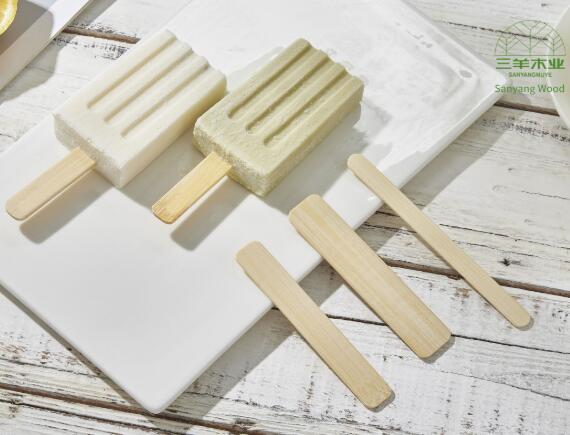

When it comes to ice cream sticks, most people don't give much thought to their material. But for businesses, manufacturers, and even eco-conscious consumers, the choice between bamboo ice cream sticks and traditional wood goes beyond functionality—it involves cost, sustainability, and brand impact.
So, is bamboo really more expensive than wood? And if it is, does it offer enough value to justify the cost? In this blog, we'll dive deep into the bamboo vs. wood comparison, exploring their differences, costs, and benefits to help you make the best choice. Let's get started!
Bamboo is a renewable resource that's gained significant popularity in recent years for its durability and eco-friendliness. It grows rapidly—up to three feet a day in some cases—and doesn't need replanting after harvest. Bamboo ice cream sticks are smooth, strong, and naturally resistant to cracking, making them perfect for frozen desserts.
Wooden ice cream sticks have been the go-to choice for decades, traditionally made from birchwood or other similar types of wood. They're reliable, readily available, and enjoy a broad and established manufacturing base. While wood sticks may lack the “green” premium appeal that bamboo offers, they remain an affordable and widely used option in the market.
As we'll discover, these materials differ significantly in terms of cost, benefits, and suitability for various needs.

Let's address the big question: Is bamboo more expensive than wood? The short answer is that it depends on key factors such as sourcing, manufacturing, transportation, and market demand. Let's break it down:
Bamboo: Bamboo is widely regarded as one of the most economical resources to grow and harvest due to its rapid growth rate. That said, because bamboo ice cream sticks are a relatively new market product, sourcing costs may be higher in some regions where bamboo production is still scaling up.
Wood: Wood remains inexpensive because it's been used for decades to produce ice cream sticks. With a mature supply chain in place, wood is often easier and cheaper to source in comparison to bamboo.
Bamboo: The production of bamboo ice cream sticks often involves newer, less-optimized manufacturing processes, potentially increasing their initial cost. However, many manufacturers are investing in automated systems that could reduce these costs over time.
Wood: Wooden stick manufacturing has long benefited from economies of scale. Decades of refinement in production mean lower costs for manufacturers and ultimately consumers.
Bamboo: Bamboo's lightweight nature can reduce transportation costs, as fewer resources are needed to ship in bulk.
Wood: Wood is slightly heavier, yet the widespread availability of wooden sticks usually minimizes transportation distances and costs.
The growing demand for eco-friendly alternatives has made bamboo products increasingly sought-after. As demand rises, production and competition often drive prices down, meaning the cost of bamboo ice cream sticks could eventually match or even become more affordable than wood.
Summing Up: While bamboo ice cream sticks may currently carry a slightly higher price tag due to newer manufacturing processes and growing demand, costs are becoming increasingly competitive with traditional wood.
Choosing bamboo isn't just about the price; it's about the added value and benefits you get in return. Here’s why bamboo is winning hearts (and markets):
Bamboo is renewable, biodegradable, and highly sustainable. It grows rapidly without requiring chemical pesticides or fertilizers, making it a highly eco-friendly choice.
For eco-conscious consumers and businesses, bamboo products send a strong message of environmental responsibility, which can enhance brand reputation.
Bamboo ice cream sticks are naturally more durable and resistant to cracking compared to wood. This reduces product defects during manufacturing and ensures a smoother customer experience.
They also feature a polished, premium look that appeals to higher-end or specialty ice cream brands.
Bamboo sticks aren't just for ice cream. They're versatile and can be used for craft projects, specialty foods, and even eco-friendly packaging designs.
Wooden sticks may not have the same sustainability buzz as bamboo, but they're far from obsolete. Here's why traditional wood still holds strong:
Wood's long-established production methods make it an affordable material, especially ideal for high-production environments like large-scale ice cream manufacturers.
People trust wooden sticks because they've been a staple in the food industry for decades. They're durable, functional, and get the job done at a consistently low cost.
While wooden sticks may win on cost and availability, bamboo ice cream sticks shine in specific situations:
Sustainability-Focused Businesses: If your brand prioritizes environmental responsibility, bamboo sticks align perfectly with your values and appeal to eco-conscious customers.
Premium Products: High-end or organic-centric dessert brands can leverage bamboo's aesthetic appeal and unique branding opportunities.
When Cost Isn't the Priority: For businesses aiming to differentiate themselves with innovative, sustainable materials, the slight cost increase with bamboo is often worth it.
If bamboo sounds like the right choice for your business, here are some ways to make it more cost-effective:
Bulk Purchasing: Larger orders often come with discounted pricing, reducing your cost per stick.
Partnering with Sustainable Suppliers: Establish long-term partnerships with bamboo suppliers who offer competitive rates for eco-friendly products.
Investing in Branding: Use bamboo sticks to enhance your brand's sustainability message, potentially increasing customer loyalty and willingness to pay a premium.
Yes, bamboo ice cream sticks may carry a slightly higher upfront cost compared to wood in some markets. However, they offer significant long-term value through sustainability, durability, and customer appeal. For businesses looking to reduce their ecological footprint or attract eco-conscious customers, bamboo is a worthwhile investment.
Meanwhile, wooden sticks remain the budget-friendly choice for large-scale production and businesses with cost efficiency as a priority.
Your Choice Matters: Whether you opt for wooden or bamboo ice cream sticks, selecting the right material aligns with your values, brand goals, and customer expectations.
Exploring eco-friendly options like bamboo ice cream sticks can elevate your brand’s reputation and appeal to a growing market of eco-conscious consumers. Contact suppliers today to discover cost-effective options and start making a sustainable impact!